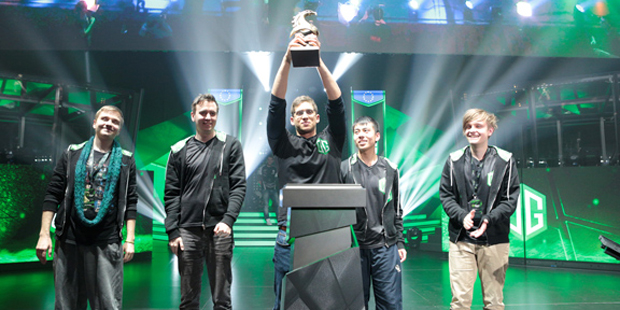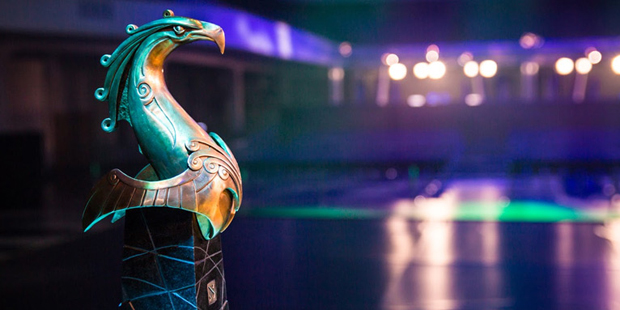Why OG winning their fourth Major isn’t bad news for professional Dota 2
It's the journey not the destination
Four of the five Dota 2 [official site] Major tournaments have gone the way of team OG. But does that mean the professional Dota 2 scene is becoming predictable? Our James argues not...
Fans of professional magician-punching were treated to a familiar sight at the recent Dota 2 Kiev Major: team OG, suddenly $1 million richer and lifting yet another first-prize trophy.
As an organisation, OG now holds the enviable position of being four-time Major winners. That’s a pretty ridiculous achievement considering there have only been five total since the format was introduced in 2015. The European Dream Green dream team aren’t the only ones with an impressive record at Valve-sponsored events either; Evil Geniuses, in addition to winning The International 2015 outright, have placed at least top 4 at TI6 and all but one Major.
This kind of sustained level of performance might be the baseline expectation of, say, a Premier League football club, but this is Dota: an ever-changing metagame and frequent roster shuffles mean it’s not unheard of for teams to be winning LANs one month and failing to even qualify the next. As such, the ability of teams like EG and OG to stay at the top for so long is almost as commendable as their actual silverware.
And yet, for every Major racked up by n0tail, Fly and the boys (to borrow caster parlance), there is an element of risk. Not to them, obviously (beyond becoming ‘the team to beat’ at the next event), but to us, the humble viewership. Could pro Dota 2 become stale? Or, if not stale, at least unsurprising?
We do, of course, see outlying performances from supposedly weak teams. Who could forget Ad Finem’s run from regional qualifiers to 2nd place overall at last year’s Boston Major? (Probably not Ad Finem, who are now Mousesports, and came last in Kiev). But even stretching back several months, Kiev’s final four seemed like a given. OG and EG were there, obviously, joined by Invictus Gaming and Virtus.Pro, easily the highest-achieving Chinese and CIS squads prior to the tournament. Has the scene really stagnated to the point where it’s all so predictable?
The thing is, the biggest reason why OG’s Majors record or EG’s near-ubiquitous podium placements both stand out so much is because they’re so rare. Only a tiny number of Dota 2 teams have actually risen to the top and stayed there.
Let’s take a closer look at OG’s record specifically:
It’s true that they’ve won four Majors, which is amazing, but their record outside of the big Valve events makes them look altogether less superhuman. Out of the seventeen non-Major LAN events they’ve played in since formation, OG have won just three, and a couple of their recent second-place finishes (namely DAC 2017 in April, and The Summit 6 last November) were 3-0 stomps in their opponents’ favour. That’s far from a bad results list, but also not that of a team which is guaranteed - or even statistically likely - to take first place next time.
[As an aside, and without wanting to diminish OG’s achievements, it’s probably worth mentioning that their four Major wins were split evenly between drastically different rosters – only Fly and n0tail, two of five, have been present for each.]
Indeed, the days of a single team (or even two or three) showing genuine, nigh-unbeatable dominance seem confined to the past. No current squad is matching Alliance’s success rate in the first half of 2013, or winning roughly one-third of every tournament they play like Na’Vi did throughout 2011 and 2012. More recent hot streaks are short-lived at best. Just look at Team Secret claiming five LANs on the trot in 2015 only to crash out of The International later sharing the 7th/8th placing with MVP Phoenix.
But if we did return to significant and sustained hot streaks, a lesson from these teams-gone-by is that having consistently strong squads in pro Dota does not harm the entertainment value of watching at home, especially not in the long-term.
On a basic level, this can be seen by virtue of the fact that dominant teams can still deliver exciting, tense or funny moments. The aforementioned series of wins for Secret included this eminently rewatchable Techies game which knocked Fnatic out of ESL One Frankfurt:
More interestingly, albeit less reliably, the presence of dominant teams – and all the expectations, hype and fan favouritism they bring – is vital to enabling the very best, most thrilling kind of games: the upsets. Recent Internationals and Majors have offered fantastic examples there.
Yes, the grand finals might get the highest Twitch numbers, but it’s the unexpected eliminations and underdog triumphs that remain on viewers’ minds and lips the longest. Take TNC Pro Team not just taking a game off OG (then merely two-time Major winners), but knocking them out of TI6 in a decisive 2-0 – that’s the stuff of Dota legend and it sits comfortably alongside the TI3 finals or Speed Gaming’s miraculous MLG Columbus run. All credit to the TNC, to be sure, but that series wouldn’t have been nearly as thrilling to watch – nor as ingrained in the competitive fandom’s psyche – had it not involved the takedown of a team which appeared set to conquer the world.
It keeps happening, too. The Boston Major saw, as mentioned, Ad Finem knock out both Newbee (who were coming off several consecutive tournament and qualifier wins in their native China) and Digital Chaos (the TI6 runners-up) on the way to the grand finals.
Later, in Kiev, little-known Brazilian team SG e-sports (apologies to the RPS style guide) broke Secret’s 20-game winning streak to send them home, and even came within a Puck ult’s width of assigning EG the same fate – not technically an upset, but the disparity between each team’s global standing inarguably made this close game even more spellbinding.
That's not to say the professional Dota 2 scene is immune to concerns about stagnation, they’re just not necessarily the result of few teams winning trophies. One possible cause for concern is the lack of new, young blood coming into the scene this year. This might change with the post-Kiev roster shuffle that’s still underway, but it does seem like both organisations and independent teams are playing it safe by only trading established players. That means 2017 isn't seeing comparable success stories to 2015 and 2016's rise of Suma1L, Miracle-, Ana, RAMZES666 and the like.
Still, in an industry where fans tend to follow the players rather than organisations, that’s not a massive issue from a viewing standpoint. What’s more disappointing is the current lack of real rivalries. EG vs OG is a fun matchup when it happens owing to each squad’s outstanding technical skills and their tendency to meet in Major elimination matches, while TNC vs Faceless is a frequent fight for the Southeast Asian top spot. But other than that, there’s not much going on. As a result - and dismiss this as drama-seeking if you so wish - it’s sadly rare to see matches with the added emotional dimension of a competitive feud.
It wasn’t always this way. EG and Secret’s 2015 rivalry had more juicy backstory than all the logs in a Bethesda RPG, and the frequent, close-fought duels between Na’Vi and Alliance over the years led to the matchup becoming known as Dota 2’s El Clásico - a name that’s survived countless roster shuffles to still be used today.
In this very specific way, then (which again has nothing to do with OG hogging all the Majors), Dota has become slightly less interesting to watch. So what’s the cause and what can be done about it?
One downside of the Major/Major/International season format is that third-party tournaments are declining in numbers. Whether it’s a lack of interest from teams, who don’t want to risk showing their strategies and hero preferences too much before a big Valve event, or merely scheduling issues, the number of top-tier contests has shrunk from 30 in 2014 to well under 20 in 2017. As well as giving fans fewer opportunities to watch their favourite teams, this also means fewer opportunities for rivalries – heck, any kind of inter-team storylines – to develop.
As for solutions, it’s risky getting Valve involved and the lack of Riot- or Blizzard-style control over its esports scene is what allowed third-party tournaments to flourish in the first place. But I’d like to see non-Majors be weighted more heavily when handing out direct invites to The International, instead of Valve automatically inviting the top four or so from the previous Major. This could encourage even high-ranking teams to play more smaller events, to maximise their collection of titles and thus their chances of a direct invite.
Speaking of Valve doing things, I’m hoping they’ll continue to provide qualifier slots for more specific regions as they did with the Kiev Major’s CIS and South America qualifiers. Those were previously integrated into the Europe and Americas qualifiers respectively. This turned out to be a fine way to facilitate those epic upsets without giving any actual advantage to the underdog team, as squads that may have not made it through larger qualifiers (SG e-sports, in this case) had a better chance of showing what they could do on the main stage and the viewing experience was all the better for it.
Maybe one day we’ll get the ultimate Cinderella story: an open qualifier hopeful from an oft-overlooked region finally getting their big break against seasoned world champions.
Until then, one final argument for pro Dota 2 still being a joy to watch despite OG’s Major dominance is the manner in which they won their latest. It was an utterly entrancing five-game brawl against Virtus.Pro, who themselves came agonisingly close to victory multiple times.
It’s a fantastic series and proof that although the outcome of a Major, an International or any other tournament may not surprise, as spectators, it’s how we arrive there that matters – and Dota 2 still has plenty of great rides to enjoy.







